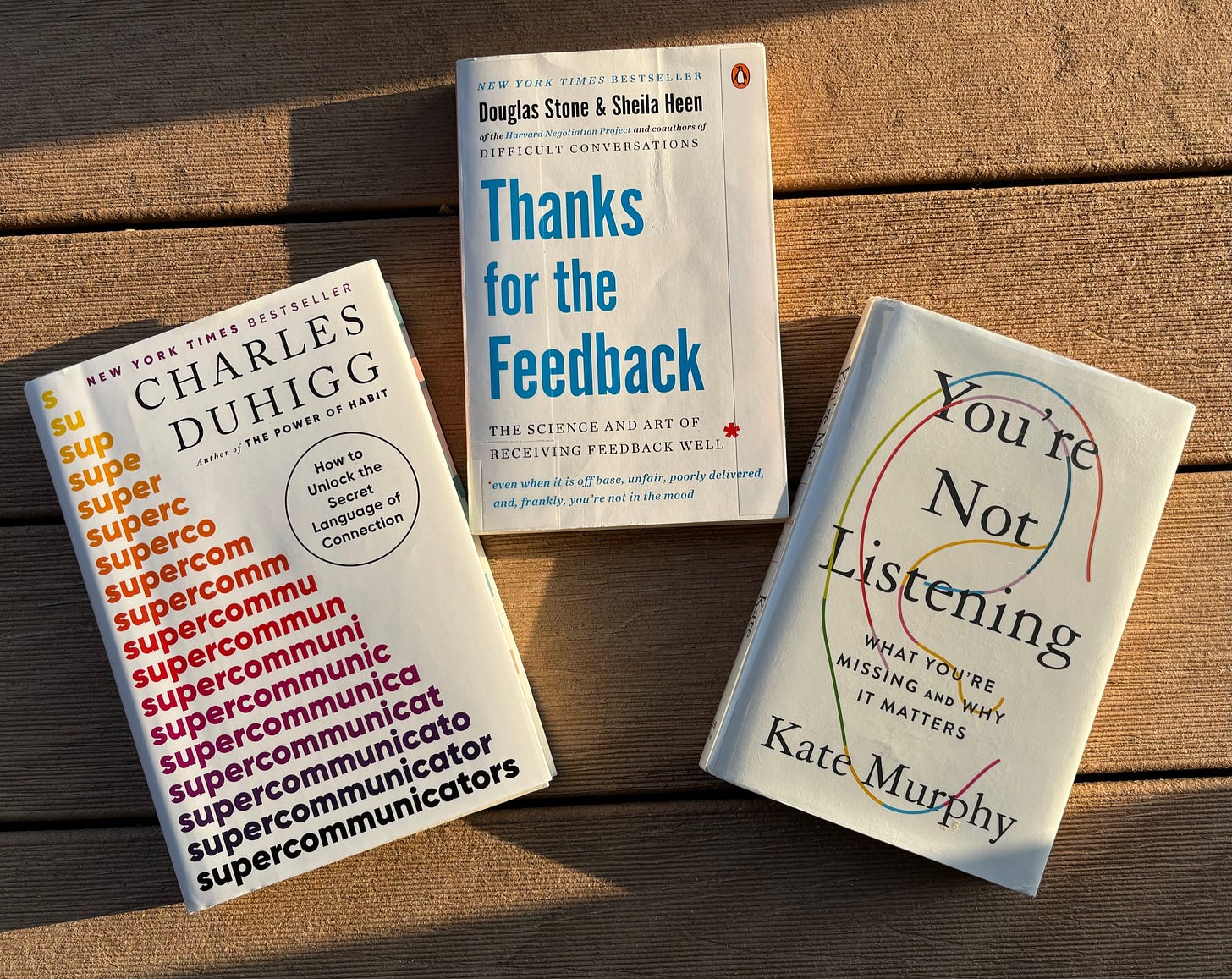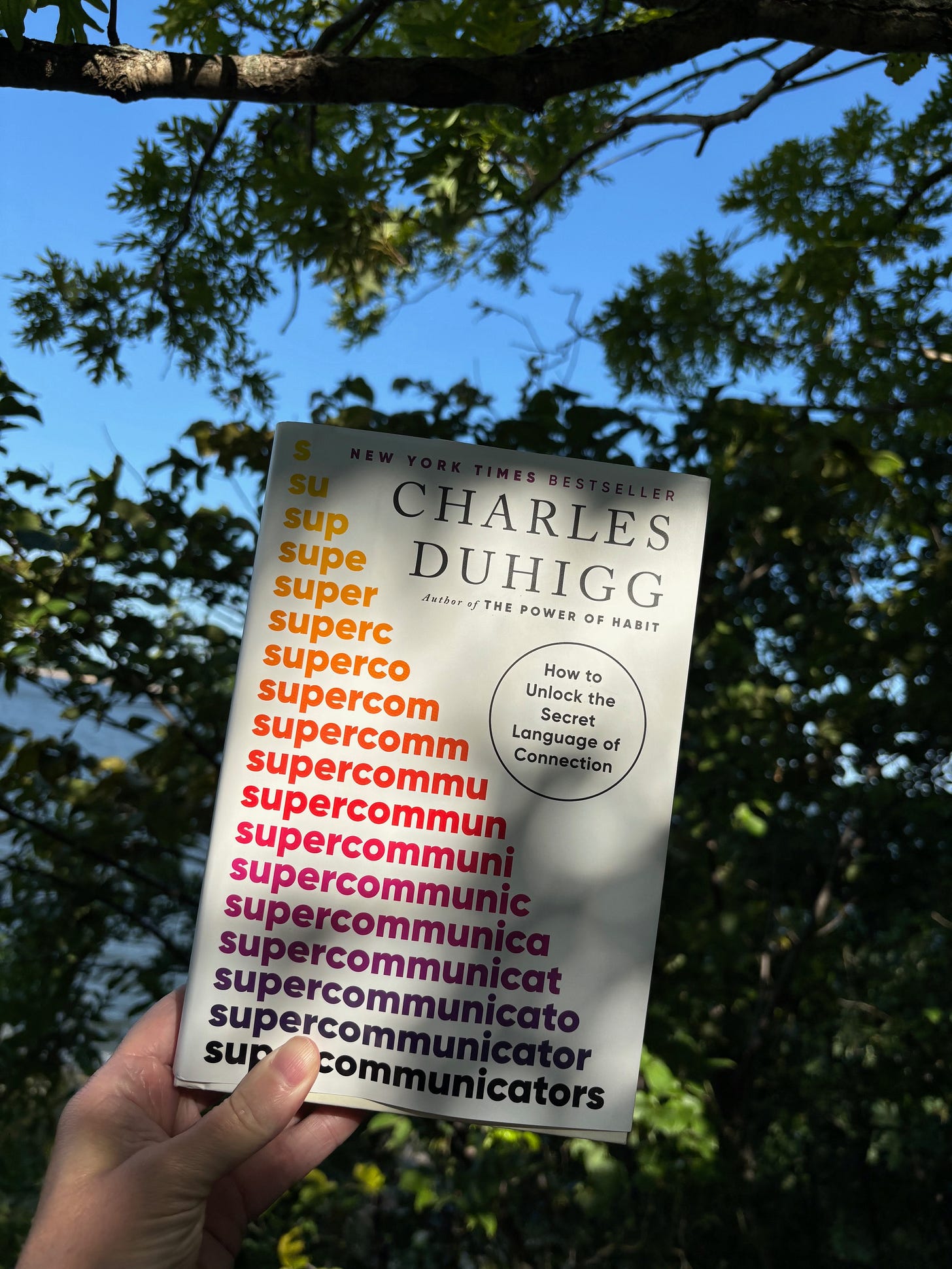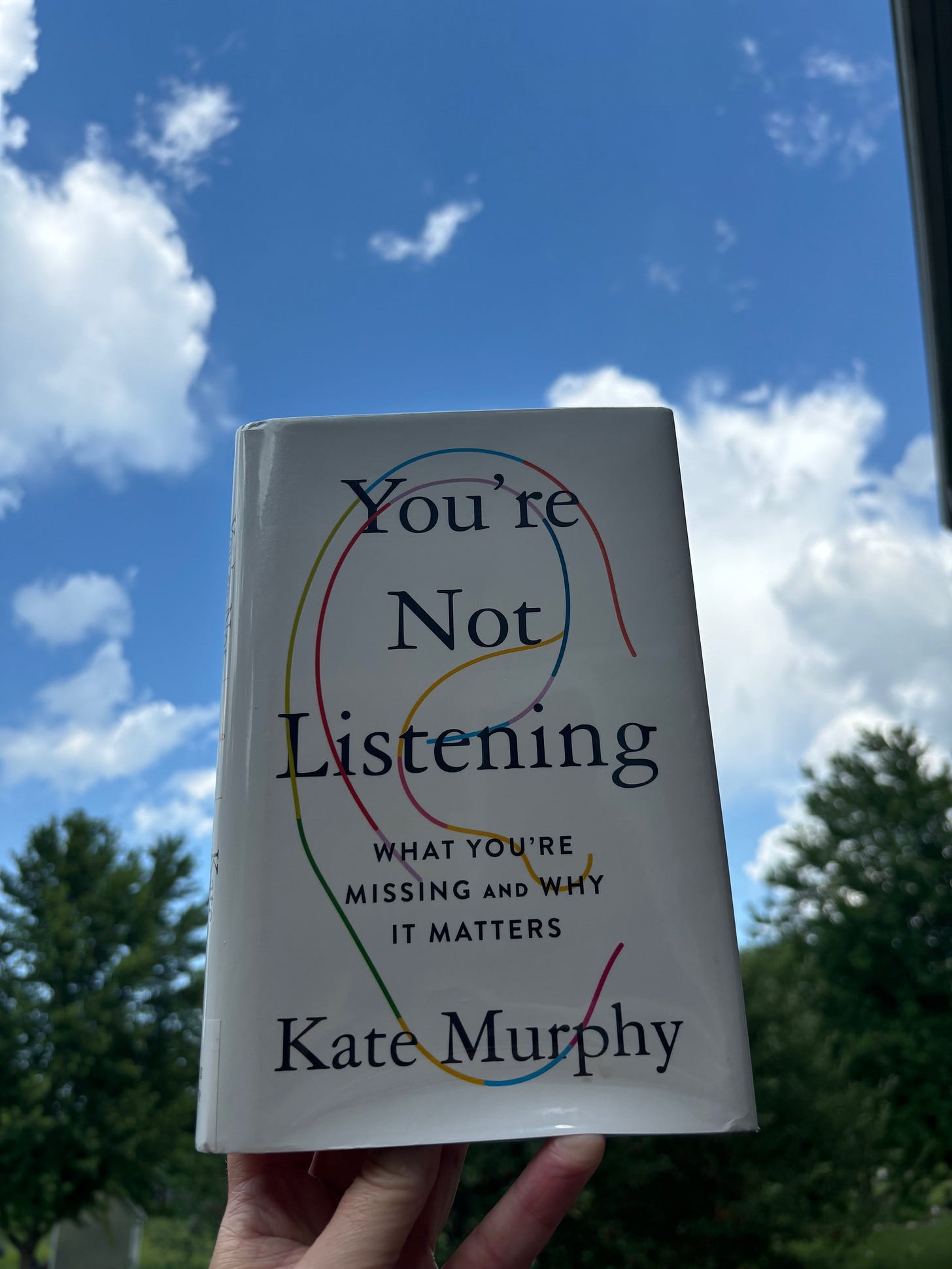Purposeful Communication: Book Flight
Wish you could communicate more effectively with your team, family, or in social situations? These tips and insights from 3 powerful books can help.
Welcome to Purposeful Book Flight #1, the first in a series of articles in which we’ll choose one important topic and highlight related tips + takeaways from three excellent books. Today’s flight focuses on communicating effectively - whether speaking, listening, or connecting in some other way. Enjoy!
If you’ve ever left a conversation wondering, ‘What just happened there?!’ - or fully convinced that two of you were in the same place but having two completely different conversations - this article is for you.
Even if you feel you have mastered the art of communication, I encourage you to read on and consider checking out one or more of these books. Throughout my undergrad courses and graduate degrees, I had countless classes in all aspects of communication, which has only expanded through continuing education in my last 21+ years as a coach and trainer.
And still, I took pages of notes from the books highlighted here!
Below, I’ll share a brief overview and two key takeaways from each of the books I’ve chosen for this Purposeful Communication book flight: Thanks For The Feedback, Supercommunicators, and You’re Not Listening.
Thanks For The Feedback by Douglas Stone & Sheila Heen
As leaders in the Harvard Negotiation Project and coauthors (along with Bruce Patton) of the best-selling book, Difficult Conversations, Stone & Heen offer a wealth of knowledge in a very accessible way with Thanks For The Feedback. Published a decade ago, the principles and action steps in this resource remain incredibly relevant today.
While this book focuses primarily on receiving feedback, learning from this perspective can offer profound insight into how to give it as well. And in my opinion, this book has one of the best subtitles ever: “The Science and Art of Receiving Feedback Well - even when it is off base, unfair, poorly delivered, and, frankly, you’re not in the mood.” :-)
Although I took oodles of notes, here are two takeaways that stand out:
1) Clarifying and discerning between types of feedback.
Stone & Heen describe three kinds of feedback: 1) appreciation - the kind that motivates, encourages, and celebrates a job well done; 2) coaching - intended to help increase growth, knowledge, or skills in some way; and 3) evaluation - which offers an assessment and/or expectations. It’s important to be able to separate these three types, as well as to ask for the type we need when possible.
If I sing in front of an audience and want to make this my profession, for example, I may benefit more from specific ideas to help me improve than from a vague ‘good job.’ If it was a one-time-only, just-for-fun performance at a neighborhood karaoke gathering, however, I might just want a quick pat on the back and move on with my life.
It’s helpful to know what will benefit you the most, and seek it out when possible.
2) Action steps with feedback.
The authors share excellent ideas for what to actually do with feedback once we’ve received it. They don’t suggest we just accept everything we hear as automatically correct, but also that we don’t disregard it as incorrect, since it may be a blind spot for us.
Instead, they encourage striving to engage in conversation around the feedback. Following up with a question like, “What’s one thing you would like to see done differently?” might be one approach, or choosing to experiment with the feedback for a time and seeing what you discover. Connecting with a coach, accountability partner, or another trusted source can prove incredibly valuable here as well.
While this book could benefit nearly anyone who engages in conversation, I’d particularly recommend it to those who routinely give and/or receive feedback - such as business professionals, managers, and other leaders. By offering numerous examples of giving and receiving feedback, as well as ways to decide - with intention - what to do with it, this book may also benefit those who tend to feel stymied by feedback.
Supercommunicators by Charles Duhigg
I first discovered Duhigg’s work over a decade ago with his book, The Power of Habit, which I consider a foundational read if you’re delving into the world of habits. I borrowed his newest release, Supercommunicators, from the library, and didn’t get very far before I had to purchase my own copy so I could highlight to my heart’s content!
One theme that runs throughout this book is the presence of emotion in a conversation - even if it doesn’t seem particularly emotional. When we recognize this, we can then be more aware of what’s truly occurring in any given conversation. “Emotions shape every conversation,” writes Duhigg. “They guide what we say and how we hear, often in ways we don’t realize. Every conversation is, in some respect, a discussion about ‘How do we feel?’” (p77)
Two (again, of many!) takeaways:
1) The types of conversations we have (perhaps without even realizing it).
Right from the first chapter, Duhigg demonstrates how two people engaged in the same conversation could actually be having two very different conversations. If you’ve ever felt misunderstood, unheard, or like your conversation partner was completely missing the point, you’ve likely experienced this.
I appreciated the simple ways we can view our conversations to determine what all parties most need/want from the exchange. For example, he describes three possible needs someone may enter a conversation with, summarized as to be helped, hugged, or heard. If someone comes to me just wanting to vent (ie, to be heard) and I’m continually coming back with suggestions for action (ie, to help), we are essentially having two different conversations.
There can be more to it, but classifying conversations in this way can prompt an aha moment for many. It also allows us to be more clear in asking for what we need - such as starting a conversation with, “I’m not looking for advice here, I’d just love for you to remind me things are going to be o.k.”
2) Preparing for conversations.
Whether you wonder how to be more comfortable at networking engagements, how to communicate online more effectively, how to approach a highly-charged or difficult conversation, or many other types of connections, Supercommunicators offers numerous suggestions, ideas, and examples.
A big part of this involves preparing for these interactions. While we don’t always have the opportunity to think through how a conversation might go before engaging in it, sometimes we do, and at other times, we have the opportunity to prepare ourselves for effective communication in general. Several sections of this book offer specific ways to prepare, such as questions you could ask others in a new setting, questions to ask yourself before a difficult conversation, and so much more.
Once I got into this book, I could not put it down - and I have tabbed and highlighted extensively. Whether you want to reach ‘supercommunicator’ status or would simply like to walk away from more conversations with a thought like, ‘That went well,’ I definitely recommend this resource.
You’re Not Listening by Kate Murphy
When we think of communicating effectively, we often focus on what we say and how we say it, not always remembering that there are at least two sides to every ‘communication coin.’ With relatable examples, insightful suggestions, and concepts we may not have previously given much thought to, this book reminds us of the equally-important aspect of listening.
I read this book way back at the start of the year and still find myself referring to it, or referring coaching clients and others to it, on a regular basis. I mostly read this via audiobook (putting my listening skills into practice as I read - so meta!) and thought the narration was terrific, if you’re looking to go that route. Two takeaways:
1) Check your assumptions.
We’ve all probably heard the old ‘When you assume…’ adage by now. But how often do you still catch yourself making assumptions - about a situation, a person, or a conversation - without even realizing it? Even if you’re intentional about checking your assumptions at the door, this probably still happens.
Throughout this book, Murphy offers example after example of how asking thoughtful questions and truly listening to the responses can change everything - from business to politics to family dinners and beyond. Whether you’re wondering about the mastery of a skilled interviewer like Terry Gross on NPR, or how con artists tend to pick up on cues to achieve their desired outcomes, or how products like the Swiffer start out compared to where they end up - all based in large part on listening - this book has something for you.
2) Listening as a form of hospitality.
I had never really thought about listening in these terms before, and I just adore this perspective. In particular, Murphy emphasizes how, when asked to share a key moment in their lives, so many people reflect on a time when someone truly listened to them - whether a teacher, a neighbor, a family member, a counselor, even a stranger.
The examples offered here can really touch your heart, and they may also surprise you: Something you thought of as a small moment in time, or a conversation you may not even recall having, might be what someone else deems a life-changing or thought-shifting moment!
So much in here provides further convincing evidence that any time we dedicate to becoming better listeners is time well spent.
One Topic, Three Books, Countless Ways To Apply!
All three of these books share some common themes but go about them in unique and thought-provoking ways. All three also offer applicable ideas that readers can put into practice to enhance communication of various forms. I will definitely continue returning to my notes on these books for reminders and reinforcement.
Now, I’d love to hear from you! Have you read any of these books? Do you plan to pick one of them up? What other books do you recommend on the topic of communication?
Share your thoughts below - including what other topic(s) you’d love to see addressed in a future Purposeful Book Flight!







